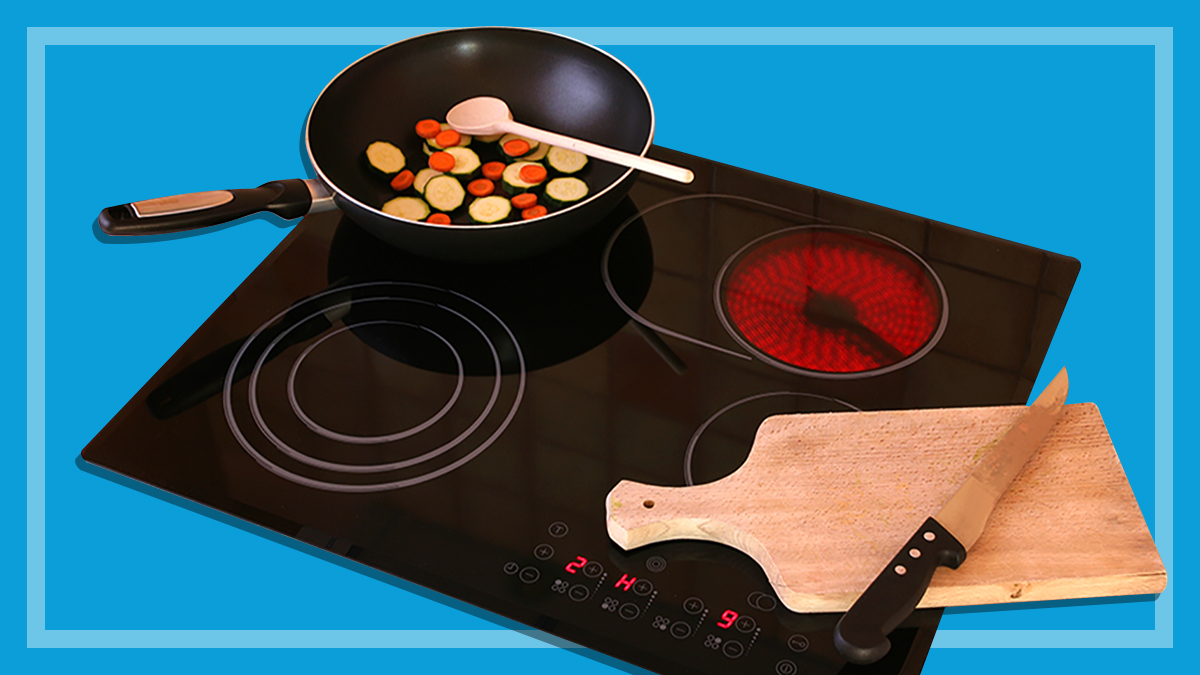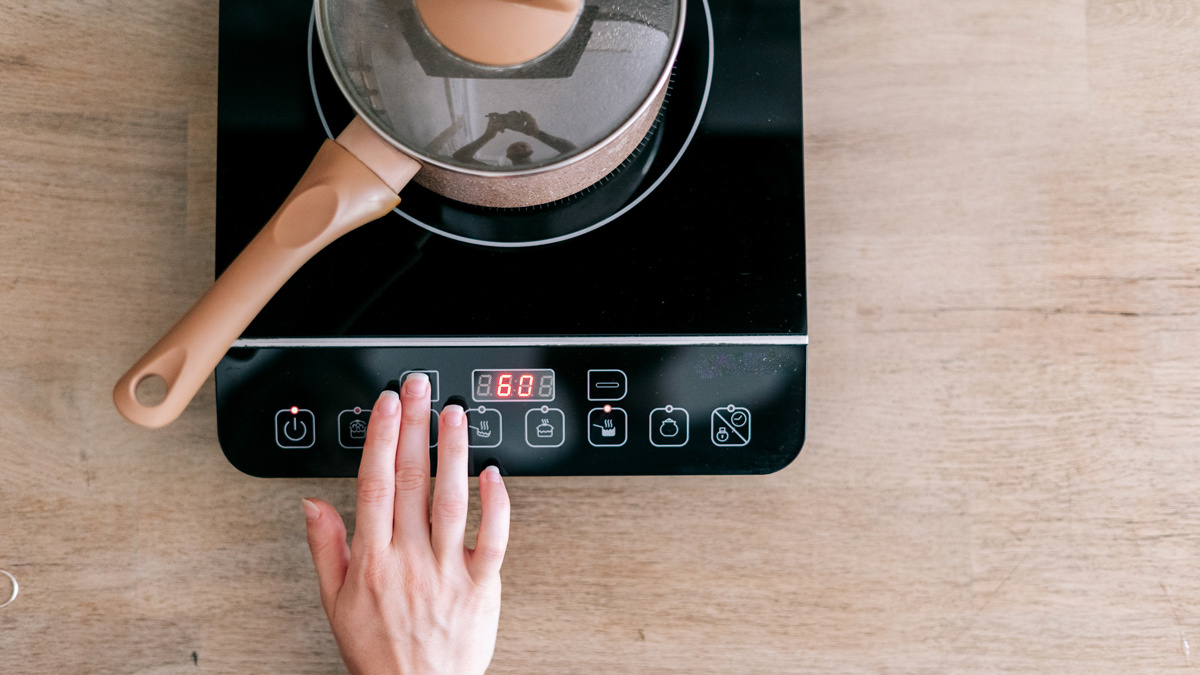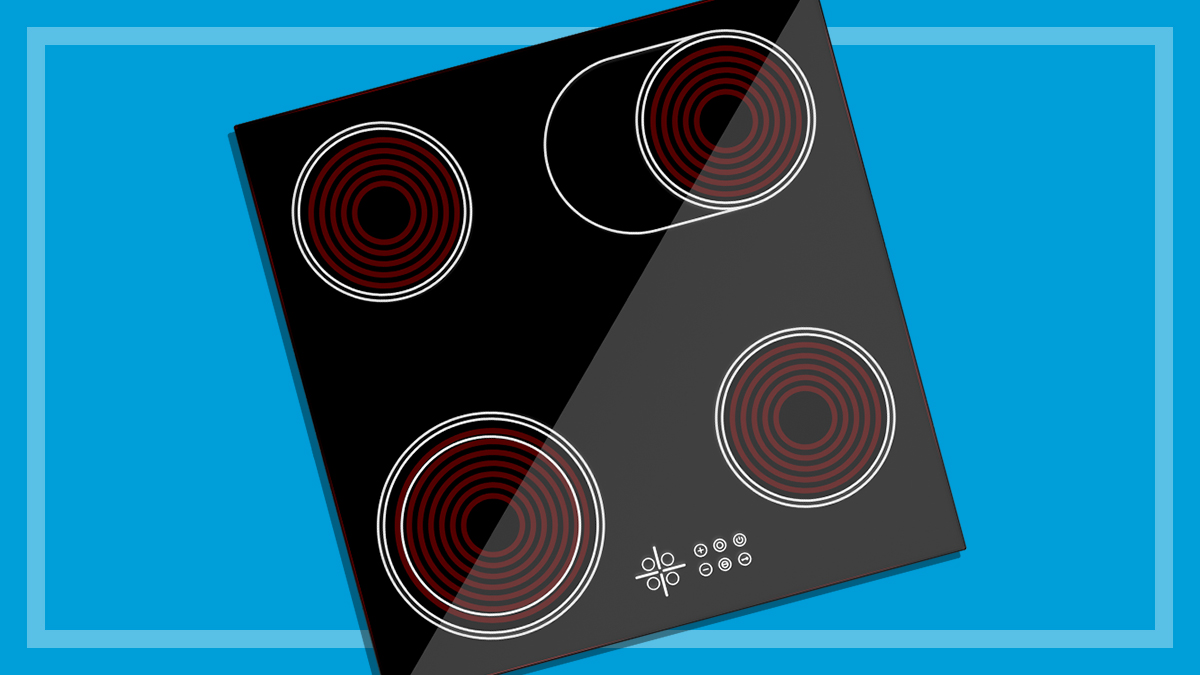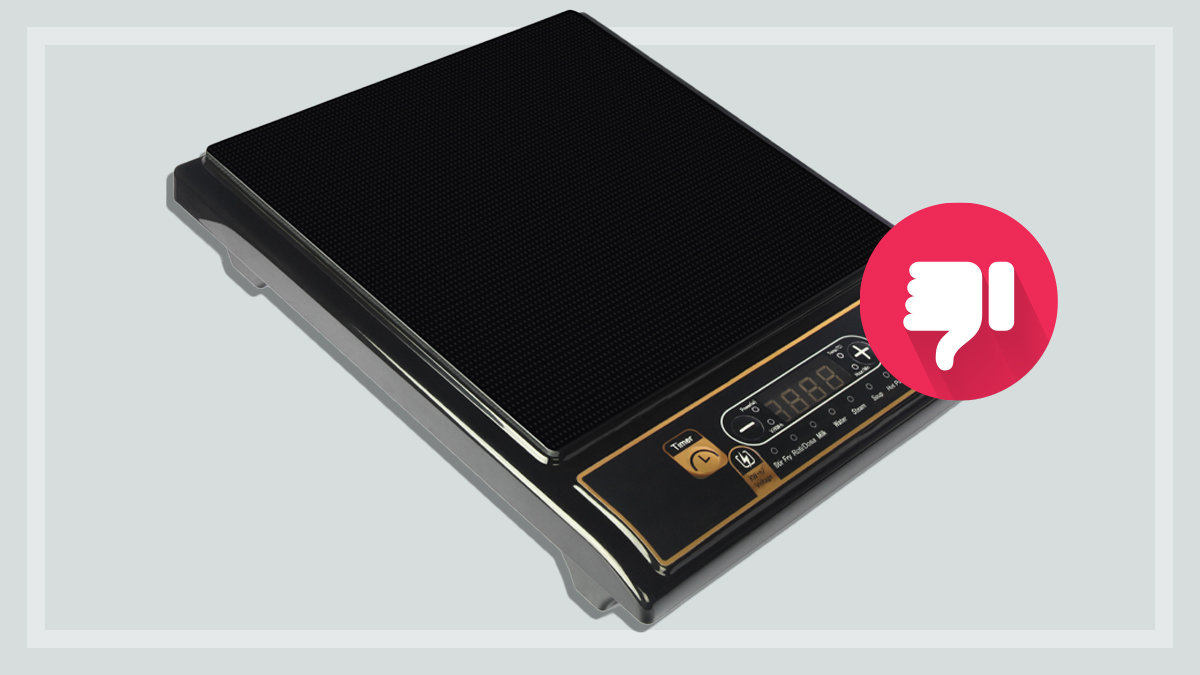How to buy a great induction cooktop
We explain how induction cooking works and look at the pros and cons.
Last updated: 11 Dec 2025
If you’re after a cooktop with super-fast heating and instant response to changes in temperature settings, all while staying cool to touch, then induction cooking is for you.
On this page:
Induction cooktops are praised for their superior cooking performance and sleek designs but deciding whether an induction cooktop is right for you really comes down to your priorities and budget.
How do induction cooktops work?
An induction cooktop looks like your typical electric cooktop, but it differs in the way it provides heat.
Rather than heating up a burner and then transferring that heat to a pot like an electric or gas cooktop, induction cooktops produce an electro-magnetic field that creates energy that heats the cookware directly.
The magnetism between the stove and cookware means your food is cooked super quickly via the heat of the cookware, not from the cooktop itself, so your stove stays mostly cool to the touch during cooking.
Induction is considered superior to other types of cooktop, providing fast heat-up and a precise and quick response to changes in temperature.
Pros and cons of induction cooktops
Pros
- Induction cooktops heat up extraordinarily fast, conveying energy to the cookware faster than any other method of cooking.
- When you change the temperature, this change is reflected immediately (like with gas), not gradually (as with a radiant ceramic element).
- Since the element itself doesn’t get hot, it’s safe to touch unless you’ve had a hot pan on it for a while.
- Most induction cooktops have automatic switches that detect when there’s nothing on the element, meaning less energy is wasted from leaving them on.
- Their flat surface means induction cooktops are a breeze to clean.
- Because the cooktop surface itself doesn’t get hot, spills onto the surface are less likely to burn onto the surface.
Cons
- You need to make sure your cookware is suitable for induction cooking and may need to replace your pots and pans if they’re not suitable.
- You may notice some noise when cooking with induction.
- Induction cooktops often require more work when it comes to installation.
What size cooktop do you need?
Whether you’re renovating your kitchen or just replacing your existing cooktop, you need to think about what size you need and how many cooking zones you’re likely to use at once.
60cm cooktop – accommodates three zones comfortably.
Fitting four zones on a 60cm cooktop can make the cooking space quite cramped, especially in regards to accessing the controls. If you’re using multiple zones at once you may find cooking can begin to interfere with the controls, making them greasy, which can in turn make them unresponsive to touch. Unless you regularly use four zones at once, we think three zones on a 60cm cooktop is all you’ll need.
70–75cm – accommodates four zones comfortably.
90cm – accommodates five zones comfortably.
If you only need one zone and you’re after something very compact and portable, you might want to consider a portable induction cooktop. We’ve tested some options in our kitchen lab, to find out how they perform take a look at our portable induction cooktop reviews.
If you’re looking to replace a freestanding oven and cooktop, our lab test includes options with induction cooktops.
How much do induction cooktops cost?
The models in our latest test of induction cooktops cost between $599 and $5549, but we’ve found that you don’t have to pay top dollar to get a good quality cooktop, so it pays to do your research.
What are the features of induction cooktops?
Important features to consider
Safety sensor
This monitors the temperature of the bottom of the cookware and adjusts the power output to avoid damage to the cookware or hob in case an empty pan is left on a cooking zone that’s turned on.
This automatically turns the element off or down in the event of overheating, or if you remove a pan. Most models have some form of this feature.
Safety cut-out
All induction cooktops have this safety feature. If a cooking zone is switched on for an extended period of time without the temperature being altered, it will switch itself off automatically. The period of time required to prompt the safety cut-out depends on the heat setting of the cooktop. The lower the setting, the longer the cooking zone will remain on.
For example, on very low heat settings, some cooktops will remain on for up to 10 hours, while cooktops using the highest setting will automatically switch off after one to one-and-a-half hours. If continuous cooking is important to you, opt for a cooktop with longer safety cut-out periods.
Auto heat-up
Auto heat-up allows the cooking zone to heat up quickly on a high heat setting, then automatically turn down to a preset heat level after a certain amount of time. This is handy if, for example, you’re cooking rice via the absorption method, when you want to bring it to the boil initially and then simmer.
Boost
This feature increases the output of the cooking zone beyond the highest numbered setting. It can only be used for boiling large pots of water (it’s perfect for boiling water for pasta or stock) and usually runs for no more than 5 minutes.
Protection against overflows
The cooktop may shut down and a beep may sound if liquid comes into contact with the controls. You can then clean the spill and begin cooking again. When choosing a model, it’s also worth considering how easy the surface will be to clean if a spill or overflow occurs – are there cracks, lips or gaps where gunk might accumulate?
Power management
Due to the high wattage some of the cooking zones have, a power management system is put in place to divide the power between two cooking zones in a pair. Therefore maximum power function can only be set for one cooking zone, while the second cooking zone can only be set to a lower power level. If you want maximum power in two pans, they need to be in opposite zones.
Auto pan detection
The induction cooktop won’t work if there’s no pan on the heating zone or the pan isn’t suitable. Also, if the pan is removed from the cooking zone, the operation is stopped and a symbol is displayed. The symbol disappears when the pan is put back to the heating zone and cooking continues with the power level set before. If unsuitable cookware is used, a symbol indicates this and after a short period of time the cooking zone switches itself off.
Cooking zones
Large cooking zones should have a diameter larger than 21cm for better efficiency when using larger cookware. Defined cooking zones have a clearer guidance for the size of cookware suitable for that zone. Choose an induction cooktop with an extra large, flexi, and small cooking zone, as these are better matched to a variety of cookware sizes.
Framed vs edgeless design
Choosing between these two design types comes down to personal preference. Keep in mind framed designs can be more prone to build-up of dirt and grime in the frame crevices. However, the frame may also help to contain any spills. Edgeless designs are simple to wipe over, but could also be more prone to damage (i.e. cracks and breaks) if you were to drop an object on the edge.
Bevelled vs non-bevelled glass finishes
A bevelled edge on an induction cooktop allows the cooktop to sit more flush when installed. On the other hand, a cooktop that doesn’t have a bevelled edge is slightly raised and therefore more exposed to knocks from sliding pans. If your cooktop has a bevelled edge, be mindful when it comes to installation as the edge can be a weak spot.
Child lock
The danger isn’t as high as with a gas or radiant cooktop, but you still don’t want the littlies playing with controls, so look out for this safety feature if you have young children in your home.
Digital control readings
Digital readouts should clearly tell you what temperature setting each cooking zone is on.
Controls
Buttons and sliders should be logical and not positioned too close to the elements.
Power on/residual heat light
These should be bright, and it’s best to have one for each cooking zone.
Pause
Some cooktops come with a pause button that temporarily locks your heating settings so you can wipe down the controls without accidentally pressing any buttons.
Keep warm
This is essentially a simmer setting that can be used to keep food warm. Some can also use residual heat.
Wok cooking
There are models that have a specially indented area for wok cooking. These models can be quite pricey, and you’d want to use your wok a lot to justify the dedicated cooking area. Alternatively, you can buy an induction compatible wok to use on any induction cooktop.
Other interesting features
App-compatible cooktops
There are models entering the market that allow you to connect your cooktop to an app. This allows remote monitoring and control, so you can check if your cooktop is turned off, even if you’re not home. You can also access recipes and other features through the app.
Hob to Hood functionality
Some cooktops can connect to a compatible rangehood through Wi-Fi. The rangehood will automatically turn on when the cooktop is in use and adjust the fan speed settings to suit the way you’re cooking.
Powerslide
This feature allows you to adjust the temperature by simply moving the cookware to a different position on the induction
cooking area. The function divides the induction cooktop into three areas with different heat settings. The hob detects the position of the cookware and adjusts the heat setting corresponding with the position. For example, you can place the cookware in the front, middle or rear position. If you place the cookware in the front you get the highest heat setting. To decrease it, move the cookware to middle or rear position.
Heat memory
This feature will remember the heat settings for a period of time if there’s a spill or if the cookware is lifted.
How to clean an induction cooktop
Induction cooktops are easy to clean. They have a continuous surface with no dirt traps, and the controls are touch-sensitive, so there are no knobs to clean around.
Because the surface doesn’t get as hot as other electric cooktops, most spillages won’t bake on – although you do have to be careful with sugar because it can burn on and create an uneven surface.
On the downside, some models don’t have a lip around the edge to contain spills, so you may have to buy a special cream to keep it streak-free.
Are induction cooktops energy-efficient?
Induction cooktops are considered to be more energy-efficient than ceramic and gas cooktops thanks to their electro-magnetic technology that delivers heat directly to the cookware.
Unlike ceramic and gas cooktops, no heat is conducted between the cooktop and the cookware, meaning less energy or heat is wasted. Also, because food is heated up much faster with induction, you don’t need to keep the cooktop on for as long.
It’s important to make sure your cookware matches the size of the cooking zone to ensure your cooktop is working as efficiently as possible.
Induction vs gas cooktops: which is right for you?
Induction and gas are both great options but you need to weigh up which one you’d prefer.
- Induction is the fastest cooking method.
- Induction and gas are much the same for heat control.
- Gas provides visual feedback when you raise and lower the flame.
- If you love to cook stir-fries, many gas models come with a specially designed burner for woks.
- Cast iron trivets on gas cooktops can be bulky and difficult to clean.
- Induction gives you a sleek surface that’s easy to clean.
- You need specific cookware for induction but this isn’t an issue for gas.
- Induction is generally the more expensive option of the two.
If gas is for you, check out our gas cooktops buying guide for tips on choosing the best model for your kitchen.
What kinds of pans are needed for an induction cooktop?
Induction requires cookware to have a ferrous bottom so the heat can be conducted rapidly, and there are some other things you’ll want to consider as well.
- Make sure cookware corresponds closely to the size of the cooking zone as this will greatly reduce the amount of energy your cooktop uses.
- Check your existing cookware by placing a magnet on the base. If it sticks well, it should be good to use on induction.
- Cast iron, steel, some enamelled steel and stainless steel pans with an iron base or core are suitable.
- Glass, aluminium and copper are not suitable.
- If you need to replace all your pots and pans, factor this into your budget and look for the induction-compatible symbol when shopping.
Find out more with our guide to buying induction-compatible cookware.
Safety considerations with induction cooktops
Is an induction cooktop safe for use by someone with a pacemaker?
Induction cooktops generate a powerful magnetic field and while this field is quite localised to the cooktop, there’s some concern that it can potentially cause interference with pacemakers and prevent them from functioning properly.
The British Heart Foundation recommends to keep a distance of 2–3 feet (approximately 60cm) between the pacemaker and the cooktop. While it may make using your cooktop slightly awkward, you can achieve this by ensuring the side of the body your pacemaker is on is facing away from the cooktop.
Manufacturers generally advise to check with your doctor before using an induction cooktop.
Is cooking with induction safe?
Induction cooktops are ideal if you have a family with small children. The surface doesn’t get as hot as a ceramic or gas cooktop, and the cooktop is only activated when suitable cookware is placed correctly on the cooking zone.
Checking food temperatures
If you tend to use food thermometers when cooking, you might find the magnetic field of an induction cooktop can interfere with a digital thermometer. This means you might need to use an analog thermometer instead.
What’s that noise?
When cooking with induction you might notice some noises. A buzz or hum is common and it may get louder at higher settings. Heavy, flat-bottomed pans might help to reduce the vibrations that cause the buzzing sound.
A whirring sound could be the fans working to disperse the heat, or a clicking sound could be an indication that your cookware isn’t working well with the cooktop.
The cooling fan for the electronics can also be the cause of some noise.
Installation and power requirements
Induction cooktops use a lot of energy and therefore can require special power connections. Some cooktops may require more power than your home can supply, so always check the total wattage before buying one. A normal everyday home plug has a 10Amp connection, whereas an induction cooktop may require a 20A, 32A or even 42A connection. These will have to be hard-wired by a licensed electrician.
The installation price will depend on how difficult it is to install the dedicated circuit from the main board in your home to the kitchen. Induction cooktops require specific dimensions to be observed when installing and this will also cost you. This is due to the large amount of heat that the cooktop needs to get rid of while operating. They generally also come with fans to disperse the heat so you’ll hear a little noise during and after operation.
Always follow the installation instructions closely and hire a licensed electrician. This will help you avoid any safety issues and ensure the long life of your cooktop.
Related
Rebecca Ciaramidaro is a Content producer in the Household team at CHOICE. Rebecca writes about a wide range of children's and household products, ranging from cots and strollers to ovens, BBQs, espresso machines and electric blankets. And also grocery items such as nappies, sanitary pads and laundry detergents.
Previously at CHOICE, Rebecca worked as a Test officer in the kitchen lab.
Rebecca has a Bachelor of Science (Nutrition and Food) from the University of Western Sydney.
Find Rebecca on LinkedIn.
Rebecca Ciaramidaro is a Content producer in the Household team at CHOICE. Rebecca writes about a wide range of children's and household products, ranging from cots and strollers to ovens, BBQs, espresso machines and electric blankets. And also grocery items such as nappies, sanitary pads and laundry detergents.
Previously at CHOICE, Rebecca worked as a Test officer in the kitchen lab.
Rebecca has a Bachelor of Science (Nutrition and Food) from the University of Western Sydney.
Find Rebecca on LinkedIn.
Fiona Mair tests and compares appliances in the CHOICE kitchen lab, from ovens, cooktops, BBQ's and air fryers, to espresso machines, blenders, food processors, microwaves, frypans and more. Fiona is also involved in Test Research, to help manufacturers with their product development for kitchen appliances. Fiona also conducts and judges food taste tests and is a judge for Sydney Royal Fine Food Show. She develops consumer-focused recipes and technical methods for testing kitchen appliances.
Fiona has a degree in home economics and dietary supervision. Fiona has been at CHOICE since 1997 and previously worked as a dietary supervisor at a children's hospital.
Fiona wants to help people to save time and money in the kitchen, reduce waste and landfill and to enjoy eating foods they've prepared from scratch.
You can find me on LinkedIn.
Fiona Mair tests and compares appliances in the CHOICE kitchen lab, from ovens, cooktops, BBQ's and air fryers, to espresso machines, blenders, food processors, microwaves, frypans and more. Fiona is also involved in Test Research, to help manufacturers with their product development for kitchen appliances. Fiona also conducts and judges food taste tests and is a judge for Sydney Royal Fine Food Show. She develops consumer-focused recipes and technical methods for testing kitchen appliances.
Fiona has a degree in home economics and dietary supervision. Fiona has been at CHOICE since 1997 and previously worked as a dietary supervisor at a children's hospital.
Fiona wants to help people to save time and money in the kitchen, reduce waste and landfill and to enjoy eating foods they've prepared from scratch.
You can find me on LinkedIn.







